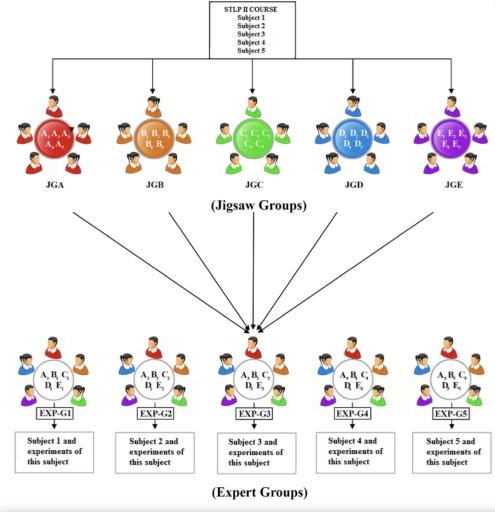Active Learning Strategy: Jigsaw
 Overview and Introduction: The WHAT and WHO
Overview and Introduction: The WHAT and WHO
Jigsaw is an activity learning strategy where groups work cooperatively to complete work that is assigned with well-established assignment expectations and outcomes [1]. The jigsaw strategy involves dividing a class into small groups of students who then work together to become experts on specific topics or pieces of information. Students are given time to study their assigned material and become experts in that area. Afterward, the students disperse and join new groups that consist of one person from each group. In these newly formed small groups, students teach their peers their knowledge on their specific content to deepen their understanding [2].
Following the group discussions, students return to their original groups, known as “home groups,” where they discuss the new content and clear up any misconceptions. The faculty member can then summarize key points, make connections with the content, hold class discussions about the content learned. To ensure that students mastered the content, make sure to include some form of assessment.
This active learning strategy encourages active participation and ensures that each student becomes a valuable resource for their peers. The collective efforts of the group members result in a comprehensive understanding of the topic [2].
Figure 1: Jigsaw Concept
Source: Adapted from [2]
The use of the Jigsaw active learning strategy creates an opportunity to shift the classroom from being a traditionally instructor-centered classroom to a more student-centered classroom. The jigsaw strategy creates a mode for students to be engaged in their own learning and the learning of their peers.
The jigsaw strategy offers flexibility and can be implemented across a wide range of courses, with careful planning. It proves beneficial for students at both undergraduate and graduate levels of education, regardless of their proficiency. A well thought-out Jigsaw can become an essential part of any course assessment experience.
| Jigsaw Pros | Jigsaw Cons |
|
|
Since the Jigsaw strategy is a cooperative learning activity, it is essential to establish a positive classroom environment by ensuring students have gotten to know one another prior to using jigsaw. One such method is to make sure students in the course have had prior opportunities to work with one another, even in simple partner activities. This allows students to informally feel more comfortable working with peers. The use of icebreakers at the beginning of a course and throughout assists in students building relationships and trust. Spending initial time providing opportunities for students to get to know one another may very well assist the overall success of groups engaging in jigsaw as students feel comfortable working with peers.

 Implementation and Timing: The WHEN, WHERE, and HOW
Implementation and Timing: The WHEN, WHERE, and HOW
Jigsaw activities can be incorporated at any stage of the course, but it is strongly advised to introduce a low-pressure jigsaw exercise at the start. Early introduction provides students with opportunities to familiarize themselves with the process, enhance their collaborative abilities, and achieve academic success. Jigsaws are adaptable and can be employed effectively in both online and in-person courses, including lecture settings. Students can benefit from receiving training about the jigsaw technique to better support implementation and understanding of the strategy [2].
Jigsaw Variation
Instead of assigning experts within the group, a variation to this is to make each group an expert on part of the content within the whole content. For example, students are asked to read an article about the ethical uses of AI in computer science. The instructor can assign each group a section within the article, establish specific criteria each group must discover and provide a timeline. At the end of time, each group presents its section, teaching the entire class about what they learned.
The jigsaw strategy can be used in a variety of courses and within varying assignments. In a university setting, clinical lab for pharmaceutical students, authors noted the difficulty students had organizing together after classes so jigsaw was used during lab sessions to aid in the learner’s ability to collaborate on labs [4].
Jigsaw can be used as a strategy to condense content but it must be noted that jigsaw is intentional in group planning, research criteria requirements and time allotments for research and expert groups and/or group presentations. It is not a strategy to simply throw at students. Consider the end goal for students. What learning outcomes will be assessed regarding the content? How will learning be assessed?
Initial Planning Considerations
- Determine how the jigsaw learning will be assessed. Might there be multiple assessments? (Group presentation of content and comprehension of the content).
- Ascertain the content that will be used to apply jigsaw. Will there be multiple articles? Will groups all have the same article but assigned specific sections to become experts in?
- Establish activity for students to work with the content. What will they teach their peers about? Will they summarize the main idea, write a pro/con list, identify problems and solutions?
- Consider how and when to group students. Grouping is intentional and needs to be a careful consideration. How many to a group? Are students pre-grouped or grouped on the day of the assignment? What are the classroom limitations? Accessibility concerns for students? An important aspect about Jigsaw and any cooperative learning strategy is that groups are intentionally diverse in ethnicity, race, gender and ability [1], [5].
- Think about training the students to use jigsaw prior to actual implementation day.
- Consider what kinds of activities students will be engaged in with the content. For example, will they need to summarize the content, locate key points, determine problems/solutions, write a pros/cons list, etc.
- Provide the rationale to learners and explain why students are using jigsaw and how it will benefit them.
- Be prepared with the content. Since each group is getting their own resource, plan on being prepared with enough resources for each group. For example: In a standard classroom size of 45 students. If there are five students in a group, there will be nine total groups. One must be prepared with nine different resources so that each group can be their own expert on a specific topic.
- Survey students after using jigsaw to collect student feedback and perceptions about jigsaw. Adjust accordingly.
Class Modality Variations
| Strategy | In-Person |
Virtual Asynchronous |
| Jigsaw |
|
***Provide more time if students need to meet outside of class [9] A. Determine the right tools for students to teach their assigned topics, like text documents, videos, webpages, discussion forums, or video conference breakout rooms. B. Next, choose four to six specific topics for students to teach each other. Make a separate discussion group for the experts. Assign each student to a group and tell them to work together to understand the topic and to create their teaching materials. C. If students will teach at different times, make multiple private Jigsaw discussion groups. If students will teach at the same time, use breakout rooms. D. Give enough time for each expert to teach their topic to the others in their group. E. Finally, bring everyone together in the whole group to hear a summary from each room’s leader and finish the activity. |

 Rationale and Research: The WHY
Rationale and Research: The WHY
Learning by teaching is a fundamental aspect of cooperative learning that brings numerous advantages to students.One possible explanation for why students show improved memory recall of their assigned jigsaw topic could be because they teach the subject to others, along with the associated preparation. This gives students the opportunity to deepen their understanding of the content [8]. Students reported using the Jigsaw strategy to teach others about the content made them learn the content more [1], [8]. They also reported feeling more comfortable asking questions of their peers than of the professor.
Faculty who employed a range of teaching strategies into their university classes throughout the semester, including jigsaw, increased student motivation in the two groups over the semester [3]. Jigsaw can be one of many strategies faculty employ to increase student motivation, engagement and learner’s comprehension of course content.
The use of Jigsaw as a cooperative learning strategy has been found to positively support a diverse range of learners in a diverse range of courses. When Jigsaw was implemented into English courses, student’s reading comprehension scores increased [6]. Students enrolled in ‘Biology for Engineers’ saw a 15% increase in performance after engaging in the Jigsaw activity. Interestingly, the use of the Jigsaw strategy in an asynchronous college computer science course improved student performance better than the use of the Jigsaw strategy in the on-ground version of the computer science course [2].See below for a condensed implementation plan based on the study.

 Additional Resources and References
Additional Resources and References
[1] J. C. Colosi and C. R. Zales, “Jigsaw Cooperative Learning Improves Biology Lab Courses,” BioScience, vol. 48, no. 2, pp. 118–124, Feb. 1998. doi:10.2307/1313137
[2] Y. M. Patil and P. D. Kumbhar, “Effectiveness of Jigsaw Strategy on students achievement in Engineering Education,” Journal of Engineering Education Transformations, vol. 36, no. S2, pp. 34–37, Jan. 2023. doi:10.16920/jeet/2023/v36is2/23005
[3] É. Tremblay-Wragg, C. Raby, L. Ménard, and I. Plante, “The use of diversified teaching strategies by four university teachers: What contribution to their students’ learning motivation?,” Teaching in Higher Education, vol. 26, no. 1, pp. 97–114, 2019. doi:10.1080/13562517.2019.1636221
[4] J. Phillips and J. Fusco, “Using the jigsaw technique to teach clinical controversy in a clinical skills course,” American Journal of Pharmaceutical Education, vol. 79, no. 6, p. 90, Aug. 2015. doi:10.5688/ajpe79690
[5] “Overview: Jigsaw in 10 Easy Steps,” The Jigsaw Classroom, https://www.jigsaw.org/#overview (accessed May 18, 2023).
[6] T. B. B. Abed, “The implementation of jigsaw as a cooperative learning strategy to improve Birzeit University EFL students’ reading comprehension”, RPD, vol. 14, no. 3, pp. 269–304, Jan. 2019.
[7] L.-K. Soh, “Implementing the jigsaw model in CS1 closed labs,” Proceedings of the 11th annual SIGCSE conference on Innovation and technology in computer science education, Jun. 2006. doi:10.1145/1140124.1140169
[8] J. M. Nolan, B. G. Hanley, T. P. DiVietri, and N. A. Harvey, “She who teaches learns: Performance benefits of a Jigsaw activity in a college classroom.,” Scholarship of Teaching and Learning in Psychology, vol. 4, no. 2, pp. 93–104, 2018. doi:10.1037/stl0000110
[9] The K. Patricia Cross Academy. “The online teaching adaptation: Jigsaw,” YouTube, June, 26, 2020. [Video file]. Available: https://www.youtube.com/watch?v=mKXY8DjtMHM. [Accessed: May 18, 2023].
Additional Resources:
